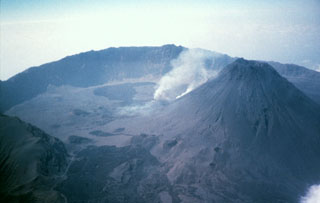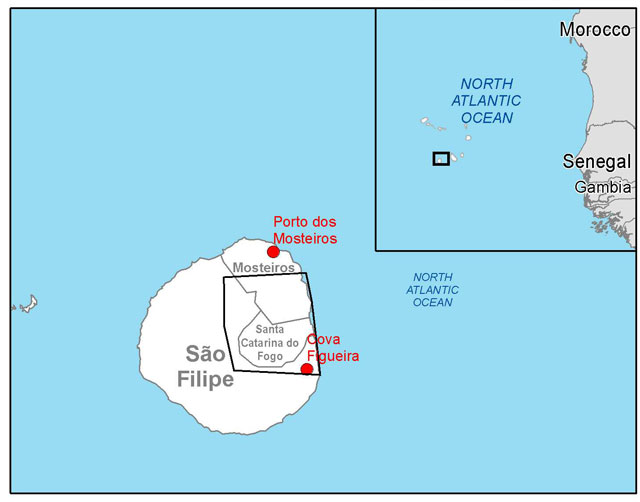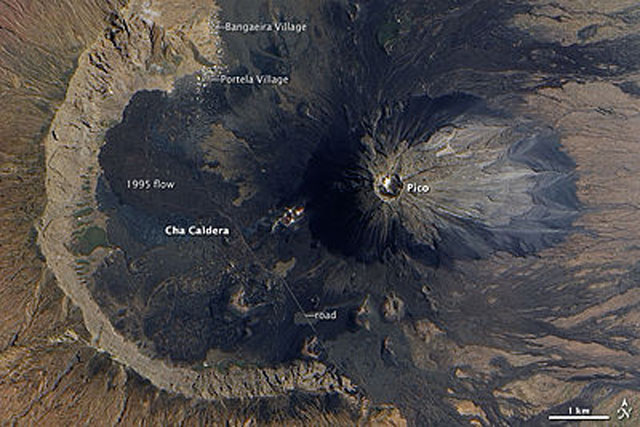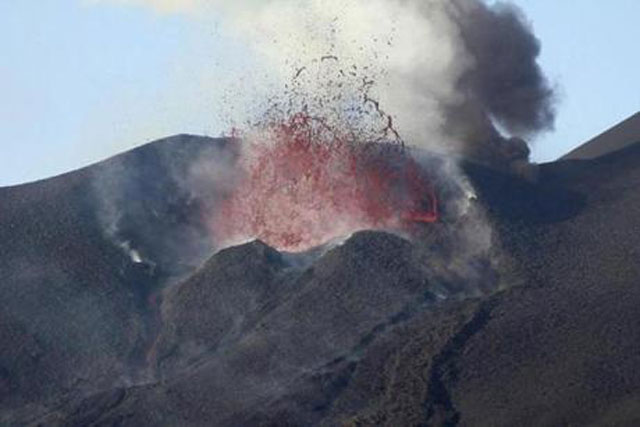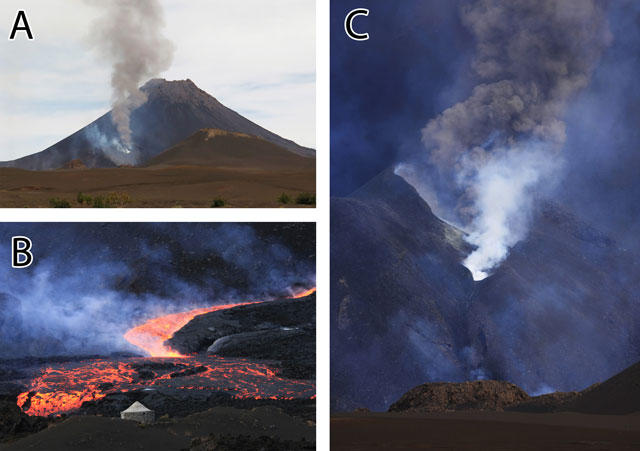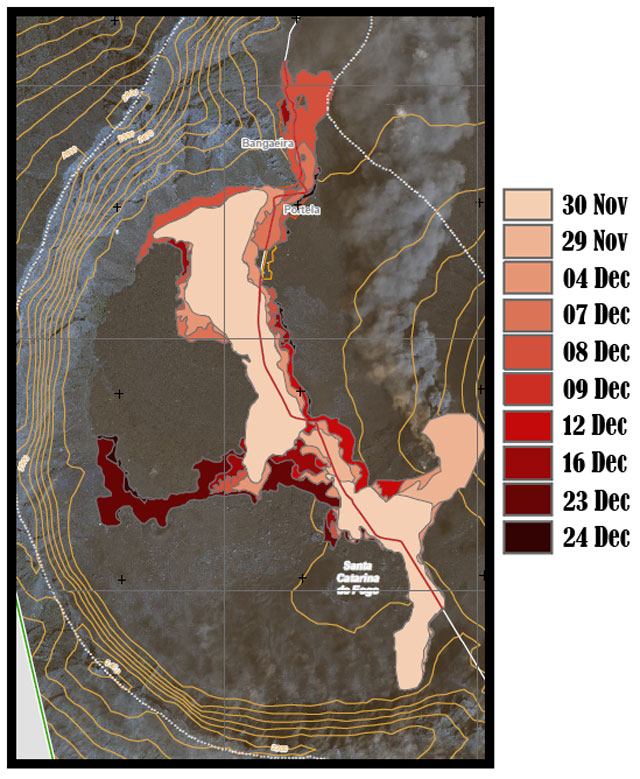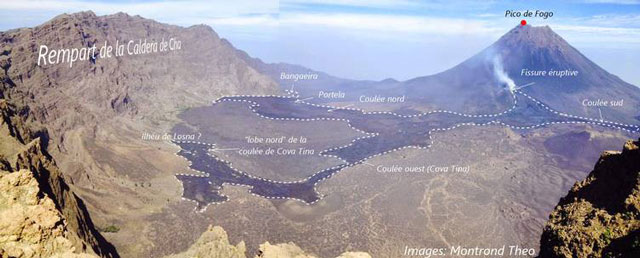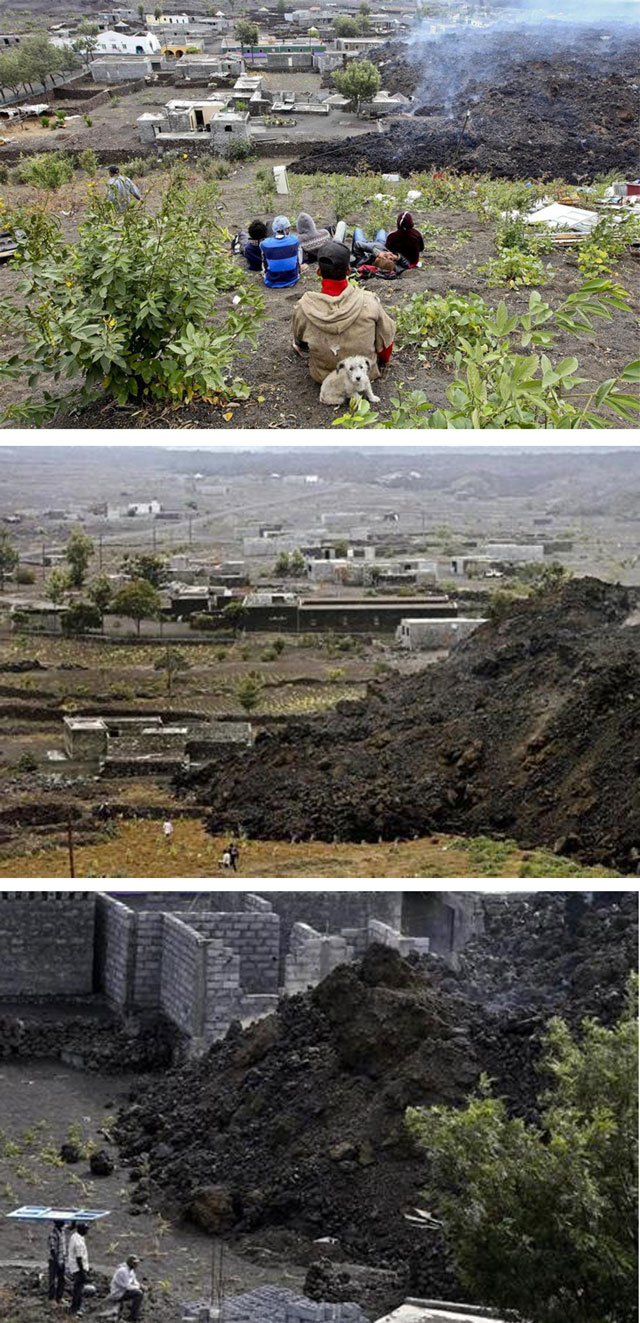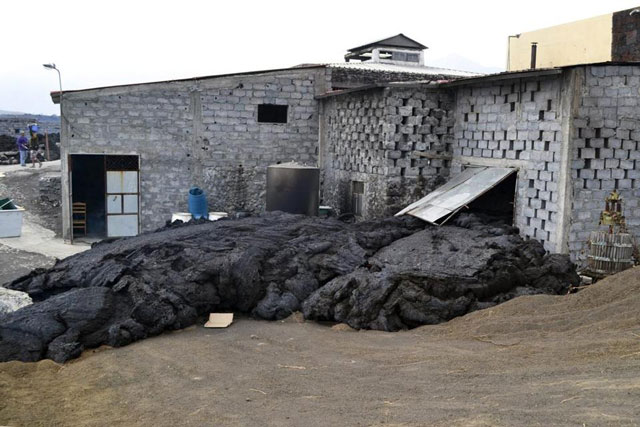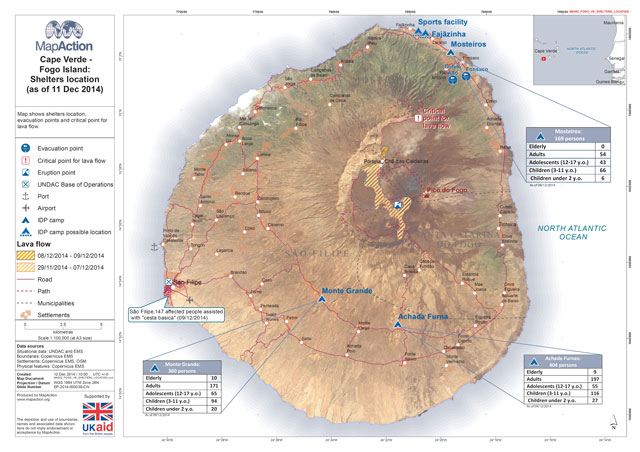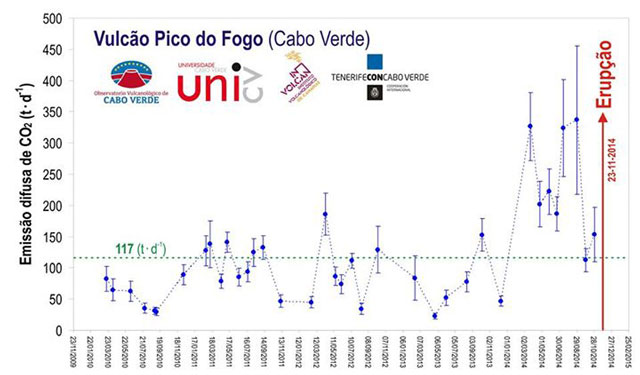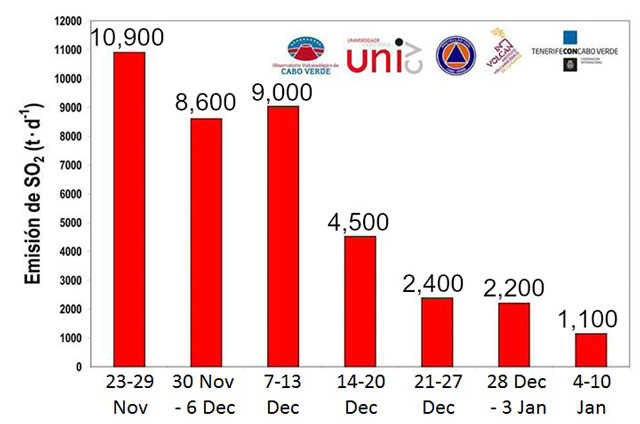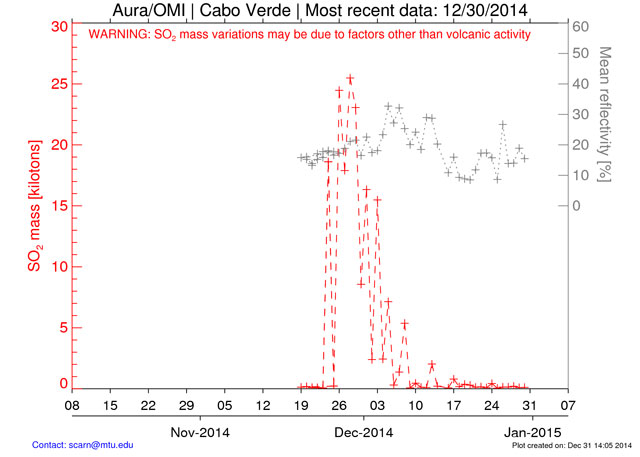Report on Fogo (Cabo Verde) — November 2014
Bulletin of the Global Volcanism Network, vol. 39, no. 11 (November 2014)
Managing Editor: Richard Wunderman.
Fogo (Cabo Verde) Eruption of 23 November 2014 and aftermath
Please cite this report as:
Global Volcanism Program, 2014. Report on Fogo (Cabo Verde) (Wunderman, R., ed.). Bulletin of the Global Volcanism Network, 39:11. Smithsonian Institution. https://doi.org/10.5479/si.GVP.BGVN201411-384010
Fogo
Cabo Verde
14.95°N, 24.35°W; summit elev. 2829 m
All times are local (unless otherwise noted)
This Bulletin report covers from June 1995 through February 2015. The interval's major volcanic event began on 23 November 2014 with the eruption of lavas. Fogo continued erupting through 8 February 2015, when the Observatório Vulcanológico de Cabo Verde (OVCV) stated that the eruption ceased. The last eruption ended in May 1995 (BGVN 20:11). There was limited information for the multi-year interval between that eruption and the one in 2014. The data for this report came from two key sources: OVCV (generally posted on their Facebook page) and Fogo News (numerous articles). Although the island of Fogo is ~25 km across and the greatest population density resides in coastal cities (red labels, figure 4), a small population also resides in the summit caldera where the venting took place. The spreading lava from the 2014 eruption covered ~4 km2 but did not escape the caldera. A pre-eruption satellite image (figure 5) labels villages within Fogo's summit caldera (Cha caldera). The intracaldera cone Pico (Pico do Fogo) is also the highest point on the island. The villages of Portela and Bangaeira sat 4-5 km NW of Pico and had a collective population of ~1,000 residents in 2009. Lavas overrode both these villages during the 2014 eruption and buried the main N-S road across the caldera. Later maps and images show various aspects of the intra-caldera lavas.
Overview on the 2014 eruption. The 23 November 2014 eruption started at 1000 local time (LT). In years prior to the eruption, the CO2 fluxes remained low and fairly stable. During the interval from 23 November 2009 to April 2014, background CO2 typically stayed well below 150 tons per day (t/d). During the March-November 2014 interval emissions increased to fluxes of ~327 t/d. Residents felt earthquakes the night before the eruption. Lava streamed from a fissure in the caldera on Pico's outer WSW flank. The initial fissure vent emerged in a location near to the vent of the 1995 eruption, though materials apparently began to vent at multiple points along the fissure. Most of the available photos showed strombolian and perhaps vulcanian activity that fed lava flows (figures 6 and 7), but news reports also indicated explosions, lava fountains, and ash emissions. An ash plume from the eruption was visible 90 km W, at the capital, Praia, on the neighboring island of Santiago (Farge, 2014). Orders were issued to evacuate the villages of Portela and Bangaeira (Caesar, 2014), and to evacuate the Parque Natural de Fogo, a large park covering much of the central part of the island (Fogo News).
On 24 November, according to the Toulouse Volcanic Ash Advisory Center (VAAC), a plume from Fogo mainly composed of sulfur dioxide extended over 220 km NW at ~9 km altitude. Lower altitude clouds contained ash.
An overview of the lava flow dispersal from the eruption is presented below, as a map with emplacement dates depicting the advancing flows (figure 8). The map was created on 25 December 2014, comparatively late in the eruption. The original map has been cropped to emphasize the lava flows, thus leaving Pico outside the area of view. At the scale of this map the summit would reside at the apex of the curving contours located along map's E margin (a spot off the map to the right and in the midst of the words "09 Dec.") The fissure vent resides in the spur of lava trending SW from the margin of Pico cone. The late stage advances seen in figure 8 (darkest red colors) roughly tripled the length of the W-trending lobe. A video on the Azores Volcanological & Geothermal Observatory website showed news footage of lava flows, which were steep-sided, rough-surfaced, and perhaps ~2-10 m high in some scenes.
That web page, and one called Culture Volcan presented an annotated still photo (figure 9) that highlighted the three lobes and the eruptive source. A key point is near the terminal end of the W lobe and the foot of the headwall, where there was a rural agricultural area with houses called Ilhéu de Losna. Culture Volcan noted damaged to farms and other infrastructure in that area. A photo not shown here showed an impressive pahoehoe lava flow that appeared to be crossing one of the farms.
An OVCV report noted that the eruption ended 8 February 2015 (a total of 77 days); and some ash columns approached 6 km in altitude. They estimated some lava flows grew as thick as 18-20 m.
Silva and others (2015) discussed the 2014 eruption chronology and presented the most complete (though still preliminary) picture of lava flow advance rates. The eruption vented on the E flank of the "1995 Pico Novo vent with the appearance of four eruptive vents" discharging gases, pyroclastic rocks, and lava. The N-directed lobe of lava associated with the destruction of Portela village included both aa and pahoehoe types. These advanced with average speeds of 1-3 to 8-10 m/hour with some cases of up to 20 m/hour (~0.3 m/min). At the vent, an initial hawaiian stage of fissure eruptions gave way to a later strombolian stage. The vent's main crater grew by the coalescence of small craters; three small vents released aa lava flows. One or two lava tubes developed. The site emitted loud explosions and strong rumbling.
A pahoehoe lava flow developed along the far end of the W-directed lobe (in the Ilhéu de Losna region, figure 9). It advanced at an average speed of 0.5 m/min. The flow here buried vineyards, other crops, and houses.
Uni-CV (Universidade de Cabo Verde) also reported that during 30-31 December, a gas-and-ash plume extended to 700-800 m above the cone drifting N and tephra was ejected 30-40 m above the vent's cone. The lava front near Ilhéu de Losna (to the W of Pico do Fogo) had stopped, while the N-directed lava front near the N part of the villages continued to flow slowly over roads and buildings. Uni-CV noted that the temperatures of the lava fronts gradually decreased. According to Uni-CV (2015), during 1-11 January 2015, dense plumes rose to 400-1,500 m above the cone and tephra rose 200-400 m above the vent. During 8-12 January, explosions were followed by noises or bangs. On 12 January 2015, continuous explosions began at 0945, growing stronger, followed by eruptive pulses. A dense, dark plume rose 2 km in height and drifted E.
On 3 February 2015 OVCV scientists saw a bluish white discoloration of the air in the caldera, which they judged as the presence of ash. Explosions were heard 1 to 4 times per minute. The ash plume rose to 0.8-1.0 km above the vent area. Rock and spatter discharged. Beginning at 1310 on 6 February 2015 scientists heard explosions at a rate of 2 to 3 per minute. The observers saw eruptive columns of brownish color that consisted of gases, tephra, and spatter that rose to 400-600 m in height above the vent. During 1345 to 1545, explosions intensified, sending out larger pyroclasts, and eruptive columns achieved heights above the crater of 1.2-1.5 km. The clouds blew NE and formed dense ash clouds. Around 1700 there occurred intervals of lowered intensity lasting a few minutes. A more energetic episode took place at 1745 on the 6th.
The 9 March 2015 report on the Uni-CV website contained numerous photos and thermal infrared images from fieldwork during early to middle February 2014. The photos showed numerous views of near vent lavas highlighting both their varied surface textures (from highly fragmental to smooth) along with temperatures up to ~700°C (measured on the basis of emissivity, atmospheric attenuation, and various inputs and assumptions in the processessing in the FLIR-brand camera). A satellite view highlights the 2014 vent area and its location perhaps ten's of meters E of the 1995 vent. Both the 2014 and 1995 vents trended NE. Other field photos revealed elongate cones constructed around the 2014 fissure vents. The inner rims of those vent-engulfing cones were encrusted with sulfur.
OVCV reported that on 8 February the eruption at Fogo had ended. SO2 emissions were almost undetectable on 8 February and continued to remain so at least through 11 February. During that period, the lava front had not moved, and only minor fumarolic activity was present at the edge of the new crater. Lava flow temperatures had dropped.
News, human impacts, and photos revealing diverse lava flow morphology. According to Fogo News, by 25 November the lava flow, which was more than 4 km in length, had destroyed much of Portella, Bangaeira and the park headquarters. Furthermore, the local (Fogo island) airport closed. Lava destroyed utility poles, hindering communications. Fogo News added that the Cape Verde government responded to the situation by creating a crisis cabinet.
On 30 November, the eruption, although quieter for a few days, resumed at dawn, according to Agencia Lusa (2014). Lava also closed the only alternative route between the Parque Natural de Fogo and the village of Portela. Travelling at ~20 m per hour, the flow destroyed dozens of homes, a large area of agricultural land, and the museum of the Parque.
A Fogo News story noted that by 2 December, the lava flow passing through Portela had destroyed the primary school, the Pedra Brabo hotel, and several additional houses. After 24 hours of remaining stagnant, the flow began again on 2 December, reportedly moving at ~9 m per hour. Furthermore, ashfall over pastures affected local livestock, especially goats. Ash emissions caused the cancellation of some flights from the island. The news also mentioned that on 6 December the lava flow rate had increased. By 8 December, the article said that about 90% of Bangaeira and 95% of Portela had been overtaken by the lava flow. After moving through the towns, the lava-flow front was ~300 m wide.
Based on a Fogo News article, Fogo volcanism decreased on 9 December. The lava flow stopped ~3.5 km from the settlement of Fernão Gomes (~5 km directly N of Pico do Fogo and just short of a steep downward slope to the towns of Cutelo Alto and Fonsaco, on the NE coast of Fogo). Gas and ash emissions also decreased and were mostly absent by 14 December. Even though the fissure vent's output was apparently low, the remaining buildings in the town of Bangaeira were overtaken by lava.
Fogo News noted that by 10 December volcanic ash had contaminated many water sources and ash had reached N of Sao Felipe on the W coast of Fogo, ~17 km SW of Pico do Fogo. As a result, the government flew in bottles of potable water.
The lava flow morphology as well as the societal impact is revealed below through a tiny sampling of available photos. The BBC (2014), and many news outlets prepared galleries on the Fogo eruption. Martin Rietze (2014) and Richard Roscoe documented portions of the eruption. Chrys Chrystello (2014) uploaded two videos to Youtube. The first one, posted on 24 November 2014, depicts plumes released from fissures and people evacuating their homes. The second one, posted on 26 November, showed evacuation, the movement of the lava flow across the caldera, and activity at night. Not depicted here are several photos and videos posted by OVCV (on its Facebook page).
Figure 10 shows three press photos posted online on 2 December. According to the captions, Portela village residents sat in the foreground, meaning that they watched as the lava flow advanced over their community. They also tried to salvage materials from the destroyed infrastructure.
Judging from the photos in figure 10, the thicker areas of lava stood higher than single story buildings. In these photos the encroaching lava front and the flow tops both appear strongly fragmental in nature, composed of blocks of diverse sizes. The lower photo in figure 10 suggests that the depicted flow front had angles of repose up to on the order of ~45 degrees. In the various photos of figure 10, the molten component of the lava flow, is not clearly apparent on the flow's exposed surface or sprouting out of the fragmental flow.
Figure 11, by contrast, depicts a compact lava flow that is clearly composed of a comparatively thin body that came right through the wall and large door in this building. The flow surface, in this case, is nearly devoid of fragmental material and the comparatively smooth upper surfaces contrast with those in the lava flows seen in figure 10. The article also noted a lack of injuries or deaths from the eruption, despite the obvious catastrophic destruction
Although, there were no fatalities, 1,076 people were displaced by the 2014 eruption. Map Action (2014), a UK-based charity, issued a map of the Fogo refugee situation (figure 12). They said that, by 11 December, the lava had covered a few square kilometers and that there were three Internally Displaced Person (IDP) shelters existing in areas well outside the caldera.
In an assessment report that was released on 16 December 2014, Relief Web said that: "A volcan[ic] eruption [on] Fogo Island, in Cabo [Cape] Verde, began on 23 November and continues as of 16 December 2014. The eruption has had direct impact on the people living in Chã das Caldeiras, the volcano crater area. 1076 people have been evacuated from the area, of which 929 have been relocated in temporary accommodation [centers] and in houses built in the aftermath of the 1995 eruption, while the remaining are sheltered in host families' homes. The affected people are a predominantly rural community, whose subsistence largely depends on agriculture and livestock. As of 16 December, national authorities report that lava has destroyed over 230 buildings, including the national park headquarters, wine and jam production facilities, a primary school, a hotel, churches, 100% of Portela and Bangaeira infrastructure, as well as more than 429 hectares [4.29 km2] of land, of which 120 hectares [1.2 km2] were agricultural land, resulting in great material and economic loss for the affected people and leaving many without a source of income."
During March 2015 online news sources showed residents in the process of road construction and building excavation.
Technical data. The average daily value of carbon dioxide fluxes at Fogo from 23 November 2009 through 2014 was compiled by four groups (figure 13). The fluxes steadily increased during the interval. Values were typically well below 150 tons per day (t/d) and had a long-term trend near 117 t/d. In March 2014, fluxes increased to 327 metric tons per day (t/d). The CO2 fluxes wavered and reached a high of ~350 t/d by a few days before the eruption. According to OVCV, the increase in CO2 suggested that pressure in Fogo's volcanic hydrothermal system had escalated, and that an eruption would soon occur.
Soil-gas radon measurements were taken during 20-21 April 2013 by project MAKAVOL (which is run jointly by the government of Tenerife, Canary Islands and the University of Cape Verde [Uni-CV]). According to the first measurements from the geochemical station FOGO-1 in Cha caldera, the soil-gas radon (222Rn) emissions were in the range of 20-160 Bq/m3, only slightly more than the natural amount in the atmosphere (~37 Bq/m3). Bulletin editors found few if any additional radon measurements leading up to the 2014 eruption.
Between 23 November 2014 through 10 January 2015, INVOLCAN (2015) published a chart showing the weekly average of daily SO2 fluxes from Fogo (figure 14). A substantial atmospheric SO2 increase from 23 November through the first week of December 2014 was also depicted on OMI satellite imagery (see separate section below), when SO2 fluxes reached a peak of ~25 kilotons (kt). The Uni-CV (2015) also reported in situ measurements of SO2 levels; they fluctuated between 869 and 2430 t/d, during 30-31 December 2014 and 1-2 January 2015.
The mini-DOAS optical remote sensing in figure 14 was also used in late November to measure the gas content of plumes, according to the OVCV. Their measurements indicated the eruption around this time released 12,000 t/d of SO2, 23,000 t/d of H2O, and 10,000 t/d of CO2 . On 30 November, the molar ratios of CO2:SO2 and H2O:SO2 were 1:5 and 8:5, respectively. According to Hernández and others (2015), other molar ratios were CO2:H2O = 0.3 and SO2:H2S = 7.5. (For more details on pre-eruption gas emissions, see Dionis and others (2015).)
According to a report by Uni-CV discussing the 8-11 February 2015 interval, their data on sulfur dioxide (SO2) monitoring were provided for civil protection, to help improve crisis management. They requested that their data not be reproduced except for reporting by the team involved in the data collection (INVOLCAN / ITER and Uni-CV). That said, we provide a brief summary and cite a few broad comments. SO2 fluxes emerging from the vent dropped to near zero during 8-11 February, one factor in determining the end of the eruption the 8th. Those low fluxes were measured by vehicle-mounted mini-DOAS insturments. From 28 November the team, with interagency support, conducted 366 measurements. One or more field trips to the vent area described conditions there during early and middle February.
According to the Uni-CV report issued 9 March 2015, during 25 January to 1 February 2015 the SO2 flux decreased. Shortly after that the fluxes rose somewhat (to several hundred tons per day
After 7 February 2015, temperatures in the vent area of both the fumaroles and at the base of the cone had decreased significantly (table 1). The temperature difference at the two distances are a well known effect associated with absorption of infrared energy as it passes through the atmosphere.
Table 1. The temperatures of the cone base and the fumaroles from 7 to 9 February 2015. Courtesy of Uni-CV (2015).
| Date | Sensors | Temperature at cone's base (°C) | Temperature of fumarole (°C) |
| 07 Feb 2015 | ~2 km away | 288 | 144 |
| 08 Feb 2015 | ~2 km away | 92 | 138 |
| 09 Feb 2015 | ~2 km away | 89 | 136 |
| 07 Feb 2015 | ~1 km away | 309 | 175 |
| 08 Feb 2015 | ~1 km away | 138 | 165 |
| 09 Feb 2015 | ~1 km away | 132 | 169 |
MODVOLC. MODIS thermal infrared sensors, aboard the Aqua and Terra satellites and processed by the MODVOLC algorithm, found hotspots infrequently at Fogo between 2001 and mid-2014; these hotspots were on the N flanks of Fogo, and thus were probably not associated with volcanic activity. On 23 November 2014, the number of hotspots increased dramatically. Hotspots were recorded daily, and many had a large number of pixels (for example, 19 pixels from the Aqua satellite on 25 November 2014). By the end of December 2014, the number of hotspots declined. During January 2015, hotspots were recorded on a total of 11 days. Only one hotspot was observed in February (7 February), and none in March.
Satellite-based SO2 emissions. Based on the OMI satellite, the 23 November eruption caused a substantial atmospheric SO2 mass increase through the first week of December 2014 (figure 15). Total SO2 mass reached a peak of ~25 kilotons.
References. Agência Lusa, 2014, Erupções vulcânicas da ilha do Fogo evoluem para "estado crítico", 30 November 2014, Observador (URL: http://observador.pt/2014/11/30/erupcoes-vulcanicas-da-ilha-fogo-evoluem-para-estado-critico/) [accessed in March 2015]
BBC, 2014, In pictures: Pico do Fogo volcano in Cape Verde erupts, 2 December 2014, British Broadcasting Company (URL: http://www.bbc.com/news/world-africa-30291041) [accessed in March 2015]
Caesar, Chris, 2014, Cape Verde Evacuations Are Underway Following Volcano Eruption, 23 November 2014, Boston.com (URL: http://www.boston.com/news/local/massachusetts/2014/11/23/cape-verde-evacuations-are-underway-following-volcano-eruption/MqqLEMCSab9qYGqlw1F5qL/story.html) [accessed in March 2015]
Chrystello, Chrys, 2014, YouTube (URL: https://www.youtube.com/user/chryschrystello/) [accessed in March 2015]
Copernicus, 2015, Fogo Island-Cape Verde, Volcanic eruption 23 November 2014 (23/11/2014) [Grading map, detail 01, Monit 12, Activation ID, EMSR-111, Product number 01FogoIsland, v1.]. Copernicus, (URL: emergency.copernicus.eu/mapping/)
Dionis, SM; Melián, G; Rodríguez, F; Hernández, PA; Padrón, E; Pérez, NM; Barrancos, J; Padilla, G; Sumino, H; Fernandes, P; Bandomo, Z; Silva, S; Pereira, J; Semedo, H, 2015, Diffuse volcanic gas emission and thermal energy release from the summit crater of Pico do Fogo, Cape Verde, 27 January 2015, Bulletin of Volcanology (URL: http://link.springer.com/article/10.1007/s00445-014-0897-4) [accessed in April 2015]
Farge, Emma, 2014, Cape Verde orders evacuation after Fogo volcano erupts, 23 November 2014, Reuters (URL: http://www.reuters.com/article/2014/11/23/us-caboverde-volcano-idUSKCN0J70SN20141123) [accessed in March 2015]
Hernández, PA; Melián, G; Dionis, SM; Barrancos, J; Padilla, G; Padrón, E; Silva, S; Fernandes, P; Cardoso, N; Pérez, NM; Rodríguez, F; Asensio-Ramos, M; Calvo, D; Semedo, H; Alfama, V, 2015, Chemical composition of volcanic gases emitted during the 2014-15 Fogo eruption, Cape Verde, EGU General Assembly 2015 (URL: http://meetingorganizer.copernicus.org/EGU2015/EGU2015-9577.pdf) [accessed in April 2015]
INVOLCAN, 2015, Nota de Prensa: Científicos del INVOLCAN continúan en Cabo Verde colaborando en el seguimiento de la erupción de Fogo, 11 January 2015 (URL: http://www.involcan.org/wp-content/uploads/2015/02/11_01_2015_Nota-de-prensa.pdf) [accessed in April 2015]
Lusa, 2014, Erupção na ilha cabo-verdiana do Fogo era "previsível", 23 November 2014, Diário de Notícias (URL: http://www.dn.pt/inicio/globo/interior.aspx?content_id=4256685) [accessed in March 2015]
Map Action, 2014, Cape Verde - Fogo Island: Shelters location (as of 11 Dec 2014), 16 December 2014 (URL: http://mapaction.org/map-catalogue/mapdetail/3671.html) [accessed in March 2015]
Rietze, Martin, 2014, Youtube, (URL: https://www.youtube.com/channel/UC5LzAA_nyNWEUfpcUFOCpJw) [accessed in March 2015]
Roscoe, Richard, 2015, Fogo Volcano, Photovolcanica (URL: http://photovolcanica.com/VolcanoInfo/Fogo/Fogo.html, https://www.youtube.com/user/Photovolcanica) [accessed in March 2015]
Silva, S, Cardoso, N., Alfama, V., Cabral, J., Semedo, H., Pérez, NM, Dionis, S, Hernández, PA, Barrancos, J, Melián, GV, Pereira, JM, and Rodríguez, F., 2015, Chronology of the 2014 volcanic eruption on the island of Fogo, Cape Verde; Geophysical Research Abstracts, Vol. 17, EGU 2015-13378 (Poster), 2015 EGU General Assembly 2015
Smith, Jennifer, 2014, Local Cape Verdeans join to support volcano victims--'Catastrophic' destruction by volcano spurs those in Mass. to help victims, The Boston Globe (URL: www.bostonglobe.com)
Uni-CV, 2015, Fórum para reconstrução da ilha do Fogo, Universidade de Cabo Verde (URL: http://www.unicv.edu.cv/index.php/arquivo-destaque/4038-2-dia-da-erupcao-equipa-da-uni-cv-faz-relatorio-do-desenvolver-da-erupcao) [accessed in March 2015]
Geological Summary. The island of Fogo consists of a single massive stratovolcano that is the most prominent of the Cape Verde Islands. The roughly circular 25-km-wide island is truncated by a large 9-km-wide caldera that is breached to the east and has a headwall 1 km high. The caldera is located asymmetrically NE of the center of the island and was formed as a result of massive lateral collapse of the older Monte Armarelo edifice. A very youthful steep-sided central cone, Pico, rises more than 1 km above the caldera floor to about 100 m above the rim. Pico, which is capped by a 500-m-wide, 150-m-deep summit crater, was apparently in almost continuous activity from the time of Portuguese settlement in 1500 CE until around 1760. Later lava flows, some from vents on the caldera floor, reached the eastern coast below the breached caldera.
Information Contacts: Observatório Vulcanológico de Cabo Verde (OVCV), Departamento de Ciência e Tecnologia, Universidade de Cabo Verde (Uni-CV), Campus de Palmarejo, Praia, Cape Verde (URL: https://www.facebook.com/pages/Observatorio-Vulcanologico-de-Cabo-Verde-OVCV/175875102444250); Universidade de Cabo Verde (Uni-CV), Av. Santo Antao, Praia, Cape Verde (URL: http://www.unicv.edu.cv/); Copernicus (The European Earth Observation Programme) (URL: http://emergency.copernicus.eu/); Cabildo Insular de Tenerife, Plaza de España, 1, 38003 Santa Cruz de Tenerife, Spain (URL: http://www.tenerife.es/); Instituto Volcanológico de Canarias (INVOLCAN), Parque Taoro, 22 38400, Puerto de la Cruz, Tenerife, Spain (URL: http://www.involcan.org/); Toulouse Volcanic Ash Advisory Centre (VAAC) (URL: http://www.meteo.fr/vaac/); Montrand Theo (URL: https://www.facebook.com/montrond.theo); Volcanological and Geothermal Observatory of the Azores, Ladeira da Mãe de Deus, 9501-855 Ponta Delgada, Portugal (URL: http://www.uac.pt/); Culture Volcan (URL: http://laculturevolcan.blogspot.com/2014/12/leruption-du-volcan-fogo-pourrait-etre.html); Mário Moreira, Instituto Superior de Engenharia de Lisboa, Portugal; Hawai’i Institute of Geophysics and Planetology (HIGP), MODVOLC alerts team, University of Hawai’i at Manoa, 1680 East-West Road, Post 602, Honolulu, HI 96822, USA (URL: http://modis.higp.hawaii.edu/); NASA MEASURES, Goddard Space Flight Center (URL: https://so2.gsfc.nasa.gov/); and Simon Carn, Department of Geological and Mining Engineering and Sciences, Michigan Technological University, Houghton, MI 49931 USA (URL: https://so2.gsfc.nasa.gov/); Fogo News (URL: http://www.fogonews.com/); and Boston.com (URL: http://www.bostonglobe.com/).

